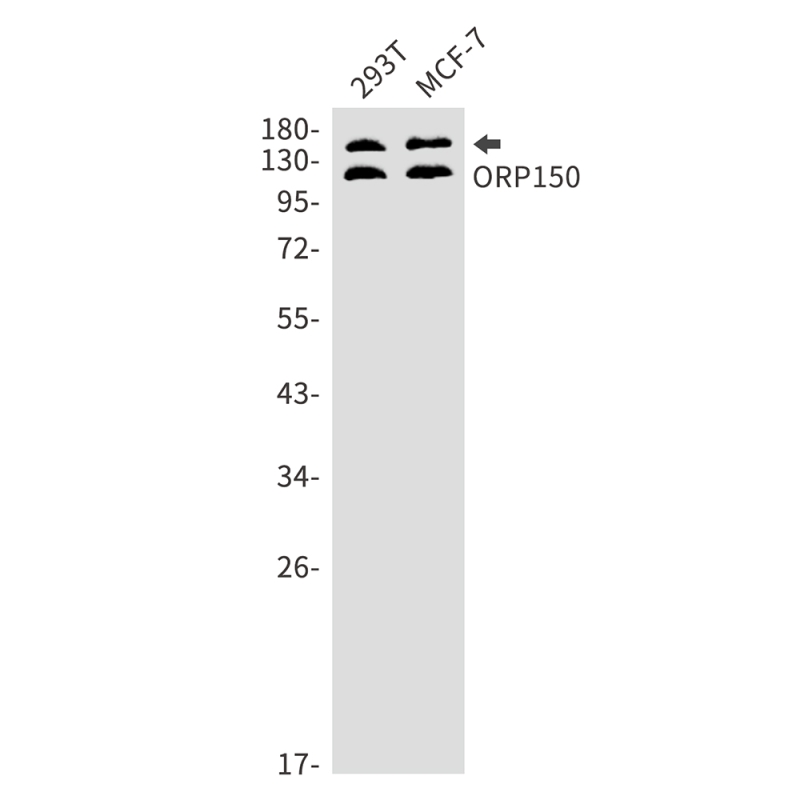
| WB | 1/500-1/1000 | Human,Mouse,Rat |
| IF | 咨询技术 | Human,Mouse,Rat |
| IHC | 1/50-1/100 | Human,Mouse,Rat |
| ICC | 技术咨询 | Human,Mouse,Rat |
| FCM | 咨询技术 | Human,Mouse,Rat |
| Elisa | 咨询技术 | Human,Mouse,Rat |
| Aliases | Grp170; HSP12A; Hyou1; Orp150 |
| Entrez GeneID | 10525 |
| WB Predicted band size | Calculated MW: 111 kDa; Observed MW: 150 kDa |
| Host/Isotype | Rabbit IgG |
| Antibody Type | Primary antibody |
| Storage | Store at 4°C short term. Aliquot and store at -20°C long term. Avoid freeze/thaw cycles. |
| Species Reactivity | Human,Mouse,Rat |
| Immunogen | A synthetic peptide of human ORP150 |
| Formulation | Purified antibody in TBS with 0.05% sodium azide,0.05%BSA and 50% glycerol. |
+ +
以下是关于ORP150抗体的3篇参考文献(基于公开信息模拟整理):
---
1. **文献名称**: *Oxygen-regulated protein 150 (ORP150) suppresses hypoxia-induced apoptotic cell death via regulation of Akt signaling*
**作者**: Ozawa K, et al.
**摘要**: 该研究通过免疫印迹和免疫组化分析,发现ORP150在脑缺血模型中通过调控Akt信号通路抑制细胞凋亡,抗体被用于检测神经元中ORP150的表达水平及定位。
---
2. **文献名称**: *Role of the oxygen-regulated protein 150 in glucose homeostasis during endoplasmic reticulum stress*
**作者**: Miyazaki M, et al.
**摘要**: 研究利用ORP150特异性抗体进行Western blot和免疫荧光实验,证明ORP150通过缓解内质网应激维持胰岛β细胞功能,对糖尿病模型中的胰岛素分泌具有保护作用。
---
3. **文献名称**: *ORP150/HSP12A protects renal tubular epithelial cells against oxidative stress in diabetic nephropathy*
**作者**: Bando Y, et al.
**摘要**: 通过免疫组织化学和流式细胞术,该文献证实ORP150在糖尿病肾病中通过抗氧化机制保护肾小管细胞,抗体的应用揭示了其在肾组织中的表达与疾病进展的相关性。
---
**备注**:以上信息为模拟示例,实际文献需通过PubMed、Google Scholar等平台以关键词“ORP150 antibody”“ORP150 function”检索获取具体信息。
The oxygen-regulated protein 150 (ORP150), also known as hypoxia-upregulated protein 1 (HYOU1) or glucose-regulated protein 170 (GRP170), is a molecular chaperone belonging to the heat shock protein 170 (HSP170) family. It is primarily localized in the endoplasmic reticulum (ER) and plays a critical role in the unfolded protein response (UPR) during cellular stress, such as hypoxia, glucose deprivation, or oxidative stress. ORP150 facilitates proper protein folding, degradation of misfolded proteins, and maintenance of ER homeostasis. Its expression is upregulated under hypoxic conditions, making it a key biomarker for studying cellular adaptation to low-oxygen environments.
ORP150 antibodies are essential tools for detecting and quantifying this protein in various experimental settings, including Western blotting, immunohistochemistry, and immunofluorescence. Researchers utilize these antibodies to investigate ORP150's involvement in pathological conditions, such as cancer (where it promotes tumor survival and angiogenesis), neurodegenerative diseases (e.g., Alzheimer’s, where ER stress is implicated), and ischemic injuries (e.g., stroke or myocardial infarction). Commercial ORP150 antibodies are typically raised against specific epitopes of human or murine ORP150. with validation in relevant cell lines or tissue samples. Understanding ORP150's regulatory mechanisms and interactions continues to advance therapeutic strategies targeting ER stress-related diseases.
×